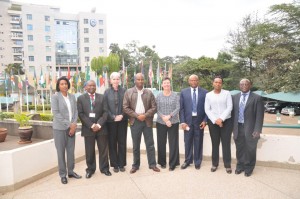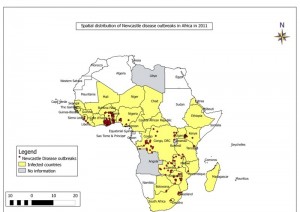Developing a continental program for village poultry – KYEEMA meets with key African Union animal health experts in Nairobi
In July this year KYEEMA Foundation’s African and Australian contingent met with representatives from the African Union’s Inter African Bureau for Animal Resources (AU IBAR) and Pan African Veterinary Vaccine Centre (AU PANVAC) in Nairobi. This marked the first planning session for an Africa-wide program for village poultry. This will see a special focus on the control of Newcastle disease (ND) and other poultry diseases such as Highly Pathogenic Avian Influenza (HPAI), as well as improved poultry husbandry. The meeting was a productive one and was thankfully relatively unhindered by the concurrent visit of USA President Barack Obama to the city.
L – R: Bethelehem Zewde (AU-PANVAC/KYEEMA), Bruce Mukanda (AU-IBAR), Mary Young (KYEEMA), Samuel Muriuki (AU-IBAR), Celia Grenning (KYEEMA), Nick Nwankpa (AU-PANVAC), Rosa Costa (KYEEMA) and Samuel Wakhusama (AU-IBAR).
Dr Bruce Mahaka opened the meeting. He reiterated the need for the program to address the four main areas of development as outlined in the Livestock Development Strategy for Africa (LiDeSA): characterise the value chain and use the information to attract private investors; enhance animal health and increase production, productivity and resilience of livestock production systems; enhance access to markets, services and value addition; and enhance innovation, generation and utilisation of technologies.
The group workshopped the main challenges and opportunities for improvement of village poultry in Africa, with a specific discussion on ND prevention led by KYEEMA. They also discussed the geographic scope for the program and developed a plan for the expected results and activities for each of the partners.
Countries reporting ND occurrence and outbreaks. Source: Animal Resource Information System (ARIS) AU-IBAR
It was agreed that improving cost-benefit of vaccine messages to farmers, reviewing investment models, linking farmers to markets, and piloting programs to convince stakeholders of the benefits are important outputs for such a program.
The general geographic scope should be primarily based on poverty indicators and ND occurrence on the continent (see above map). The project could build on the AU-IBAR Live 2 project under development but focus on poultry. Specific country selection criteria could include previous KYEEMA project participation for continuity, ND status and reporting, poverty index, operational environment, food security situation and regional representation.
The expected results and activities for the program were drawn up from a clear strategic objective framework. Proposed activities include:
- Improved outreach of veterinary services to male and female village chicken farmers.
- Develop/revise/adapt strategies for the control of ND and other priority poultry diseases at continental, regional and national level.
- Expand access to quality vaccines.
- Develop/implement models for sustainable vaccine distribution networks.
- Design and implement vaccination campaigns for sustainable control of ND and other priority diseases.
- Strengthen and harmonize Master trainer curricula and training.
- Identify suitable low cost materials for feed (including performing nutritional analysis and balance ration formulation by season) and housing.
- Train male and female village poultry farmers in good practice in poultry husbandry; promote use of farmer field schools.
- Establish and enhance stakeholder organisations.
- Train stakeholder organisatons in marketing, including pricing, quality control, sanitary slaughter procedures, market biosecurity.
- Identify, pilot, establish, invest and promote successful village poultry value chain models.
- Promote innovative public-private partnerships enabling private sector participation in the provision of services and inputs in the village poultry value chain.
- Promote local production and intra-regional distribution of essential inputs and supplies including setting up a database of preferred suppliers for inputs required along the supply chain.
- Enhance market oriented village poultry production.
- Identify and document the socio-economic benefits and potential of the village poultry sector.
- Select, promote and disseminate appropriate technologies through extension services and support research institutions to undertake village poultry research and development activities including competitive funds for relevant research activities and interactive resource website.
The overall budget proposed for the program was 25 million USD over 5 years. KYEEMA is currently working with AU IBAR and AU PANVAC to finalise the draft proposal. Watch this space.




